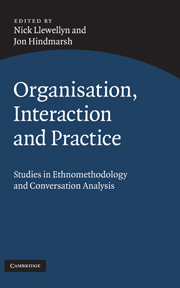2 - Finding organisation in detail: methodological orientations
Published online by Cambridge University Press: 20 May 2010
Summary
Introduction
Contributions to this volume direct attention to the real-time achievement of organisational processes and practices. This demands distinctive data and methodological resources, and the chapters that follow adopt one particular empirical approach to engage the ethnomethodological (EM) project, one that draws heavily from conversation analysis (CA). In all cases, the authors subject recordings of everyday work and organisational conduct to detailed sequential and interactional analysis.
The use of audio and/or video recordings offers intriguing opportunities for studies of work. The equipment to produce them is cheap and reliable, and they deliver real-time recordings of work in progress that can be subjected to repeated scrutiny and evaluation. As Harvey Sacks suggested, ‘tape-recorded materials constitute a “good enough” record of what happened. Other things, to be sure, happened, but at least what was on the tape had happened’ (Sacks 1984: 26). So, as with other data types they are limited in coverage, but unlike other data types they offer a density and permanence that can be very valuable (Grimshaw 1982). They exhibit density in that they are rich in the details of the recorded events; it is very common to notice new and subtle features of activity upon repeated re-viewing of recordings. They are also persistent and cumulative, providing researchers with the opportunity of preserving and comparing data across various projects. Furthermore, recordings allow researchers to show and share materials, so that others can judge for themselves the persuasiveness of insights and analyses.
- Type
- Chapter
- Information
- Organisation, Interaction and PracticeStudies of Ethnomethodology and Conversation Analysis, pp. 24 - 46Publisher: Cambridge University PressPrint publication year: 2010
- 6
- Cited by



